-
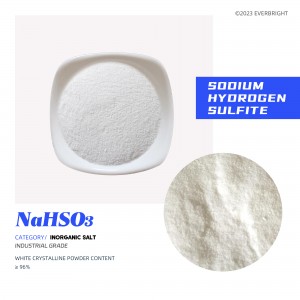
Sodium Hydrogen Sulfite
In fact, sodium bisulfite is not a true compound, but a mixture of salts that, when dissolved in water, produces a solution composed of sodium ions and sodium bisulfite ions. It comes in the form of white or yellow-white crystals with an odor of sulfur dioxide.
-
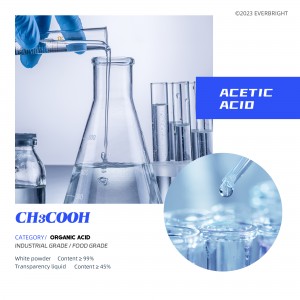
Acetic acid
It is an organic monic acid, the main component of vinegar. Pure anhydrous acetic acid (glacial acetic acid) is a colorless hygroscopic liquid, its aqueous solution is weakly acidic and corrosive, and it is strongly corrosive to metals.
-
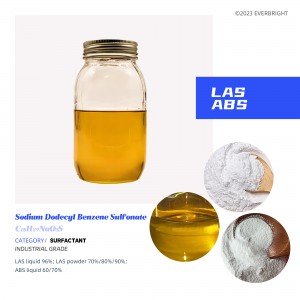
Sodium Dodecyl Benzene Sulfonate (SDBS/LAS/ABS)
It is a commonly used anionic surfactant, which is a white or light yellow powder/flake solid or brown viscous liquid, difficult to volatilization, easy to dissolve in water, with branched chain structure (ABS) and straight chain structure (LAS), the branched chain structure is small in biodegradability, will cause pollution to the environment, and the straight chain structure is easy to biodegrade, the biodegradability can be greater than 90%, and the degree of environmental pollution is small.
-

Dodecylbenzenesulphonic acid (DBAS/LAS/LABS)
Dodecyl benzene is obtained by condensation of chloroalkyl or α-olefin with benzene. Dodecyl benzene is sulfonated with sulfur trioxide or fuming sulfuric acid. Light yellow to brown viscous liquid, soluble in water, hot when diluted with water. Slightly soluble in benzene, xylene, soluble in methanol, ethanol, propyl alcohol, ether and other organic solvents. It has the functions of emulsification, dispersion and decontamination.
-

Sodium Sulfate
Sodium sulfate is sulfate and sodium ion synthesis of salt, sodium sulfate soluble in water, its solution is mostly neutral, soluble in glycerol but not soluble in ethanol. Inorganic compounds, high purity, fine particles of anhydrous matter called sodium powder. White, odorless, bitter, hygroscopic. The shape is colorless, transparent, large crystals or small granular crystals. Sodium sulfate is easy to absorb water when exposed to air, resulting in sodium sulfate decahydrate, also known as glauborite, which is alkaline.
-
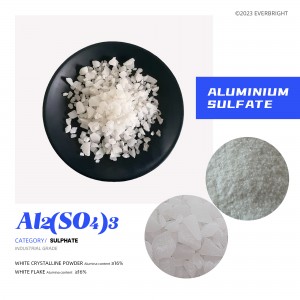
Aluminium Sulfate
Aluminum sulfate is a colorless or white crystalline powder/powder with hygroscopic properties. Aluminum sulfate is very acidic and can react with alkali to form the corresponding salt and water. The aqueous solution of aluminum sulfate is acidic and can precipitate aluminum hydroxide. Aluminum sulfate is a strong coagulant that can be used in water treatment, paper making and tanning industries.
-
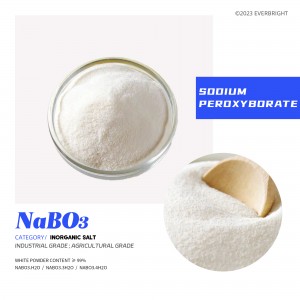
Sodium Peroxyborate
Sodium perborate is an inorganic compound, white granular powder. Soluble in acid, alkali and glycerin, slightly soluble in water, mainly used as oxidant, disinfectant, fungicide, mordant, deodorant, plating solution additives, etc. Mainly used as oxidant, disinfectant, fungicide, mordant, deodorant, plating solution additive and so on.
-
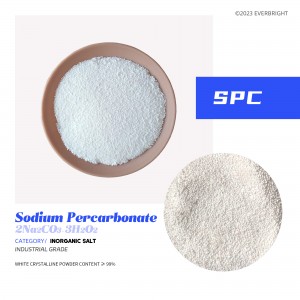
Sodium Percarbonate(SPC)
Sodium percarbonate appearance is white, loose, good fluidity granular or powdery solid, odorless, easily soluble in water, also known as sodium bicarbonate. A solid powder. It is hygroscopic. Stable when dry. It slowly breaks down in the air to form carbon dioxide and oxygen. It quickly breaks down into sodium bicarbonate and oxygen in water. It decomposes in dilute sulfuric acid to produce quantifiable hydrogen peroxide. It can be prepared by the reaction of sodium carbonate and hydrogen peroxide. Used as an oxidizing agent.
-

Sodium Tripolyphosphate(STPP)
Sodium tripolyphosphate is an inorganic compound containing three phosphate hydroxyl groups (PO3H) and two phosphate hydroxyl groups (PO4). It is white or yellowish, bitter, soluble in water, alkaline in aqueous solution, and releases a lot of heat when dissolved in acid and ammonium sulfate. At high temperatures, it breaks down into products such as sodium hypophosphite (Na2HPO4) and sodium phosphite (NaPO3).
-

Magnesium Sulphate
A compound containing magnesium, a commonly used chemical and drying agent, consisting of the magnesium cation Mg2+ (20.19% by mass) and the sulfate anion SO2−4. White crystalline solid, soluble in water, insoluble in ethanol. Usually encountered in the form of the hydrate MgSO4·nH2O, for various n values between 1 and 11. The most common is MgSO4·7H2O.
-

CDEA 6501/6501h (Coconutt Diethanol Amide)
CDEA can enhance the cleaning effect, can be used as an additive, foam stabilizer, foam aid, mainly used in the manufacture of shampoo and liquid detergent. An opaque mist solution is formed in water, which can be completely transparent under a certain agitation, and can be completely dissolved in different kinds of surfactants at a certain concentration, and can also be completely dissolved in low carbon and high carbon.
-

Sodium Bisulfate
Sodium bisulphate, also known as sodium acid sulfate, is sodium chloride (salt) and sulfuric acid can react at high temperatures to produce a substance, anhydrous substance has hygroscopic, aqueous solution is acidic. It is a strong electrolyte, completely ionized in the molten state, ionized into sodium ions and bisulfate. Hydrogen sulfate can only self-ionization, ionization equilibrium constant is very small, can not be completely ionized.







